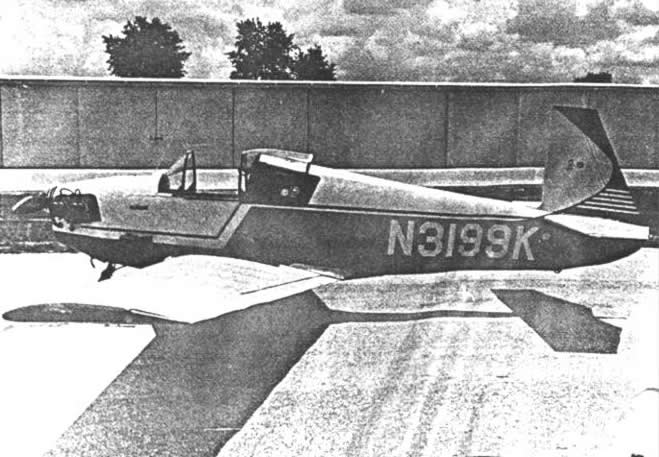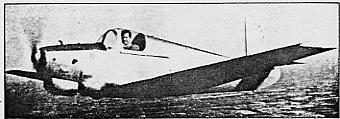
The First "Mooney"
Mooney Mite No. 1 First Flew with a Crosley
Engine
by Ace Bowman
This article is taken from the September 1977 issue of PRIVATE PILOT.

Here's how Kala's Mite appears in
"Jane's All the World's Aircraft" when
it was powered by a 25-hp Crosley
car engine.
IT'S A PROTOTYPE; it's a plane; it's a 201; it's N3199K; it's a "grabbit." In FAA exam jargon, it's all the above.
To weld it all together, it is M-18C-1, the First Mooney Mite ever built, according to the logbooks and the 1948 edition of Jane's All The World's Aircraft. It first flew in April, 1947, as indicated by Al W. Mooney's sign-off in the books.
At that time, its Civil Aeronautics Administration number was NX3199K.
How one gets to the 201 answer is a bit trickier, just like a sneaky FAA question should be. Suffice to say that after a couple of years of changing engines around and effecting other modifications, the manufacturer's serial number on the Mile ended up 201. That number, now very popular in Kerrville, Texas, still is engraved on the little bird's Manufacturer's Aircraft Association I.D. plate.
Grabbit? The Mooney Mite belongs to that elite family of aircraft which cause an aviator, on sighting the craft, to want to grab it and take off. Close relatives are ancient Wacos, P-51s and Learjets.

Johan Kala ... Mooney Mite No. 1 owner and restorer.
The proto-Mite is owned by Johan Kala and hangared between flights at the DeLand, Florida, Airport.
Johan, a licensed A & P at J. Aero Activities, DeLand, acquired the craft from a DeLand resident last February. Since that time, he's spent considerable time restoring the airplane to its original configuration. However, Kala is proceeding slowly on a task-at-a-time basis so that he also can fly it regularly.
Born three years after his Mite, Kala is a native of Finland. He arrived in New York in 1967 when his father was assigned as Consul General there by the Finish Government.
It did not take Johan long to catch on to American ways, and his entry into the aviation business began with the traditional step of hanging around the airport.
The airport in this instance was the one at Islip, New York, and after the usual apprenticeship period spent as a "gopher," he obtained his Private Pilot ticket.
The next rung up the ladder for Kala was his A & P License, which he obtained at the Academy of Aeronautics, New York.
Around 1973, Johan decided to seek warmer weather while pursuing more aviation education and training. He arrived at Embry-Riddle Aeronautical University, Daytona Beach, and decided he had found what he was looking for.
Kala graduated from E-RAU with a Bachelor of Science degree in Aviation Maintenance Management in 1975. Since that time he has worked for Piper Aircraft in Vero Beach and at Daytona Beach - DeLand area airports.
Johan is extremely pleased with his acquisition, and finds it a challenge to fly and to work on.
Putting those early Mooney Mites into production was quite a hassle, though.
First, the aircraft was going through its growing pains stage during the post WW-II period when the general aviation industry euphorically believed the family aircraft was going to displace the family car, or at least relegate the latter to hopping cart chores. The Mite, with its single-place cockpit (a half-place cockpit if you are 6-foot-3 and wear size 13D -shoes) hardly Fit the McColl's magazine image of a family airplane. It's main virtue was economy.
Next, there was a series of engine problems which, as ever, led to hacked-in airframe modifications, a burdensome problem on a craft of Mite's dimensions. Finally, in spite of what others might tell you, CAA red tape was just a little shorter but every bit as sticky as the FAA brand is now; we just keep relearning the lesson.
Kala's Mite finally got its own CAA certification in March, 1950, though many of its progeny had been produced and sold a year earlier.
Even a casual glance will confirm that the Mite is pure early Mooney. Kala pointed out some of the few modifications that previous owners had made and which he wants to return to original form.
The current powerplant is a 65-hp Continental A-65-8, which for most Mooney Mite buffs is pure enough. A lot of them were produced that way. How- ever, NX 1399 originally was powered by a 25-hp Crosley engine and Kala is looking for one for this Mite.
The search probably won't be easy, though. The old Crosley four-banger was not an overwhelming favorite even back in '47. It was a modified cast iron auto engine, liquid cooled (a landing light fills the void left by removal of the radiator on Kala's Mite).
Another log remark by Al Mooney to the effect that a Crosley crankshaft had broken in flight probably did little to add to the popularity of the iron engine around the original Mooney plant in Wichita. Anyway, the Crosley engine soon was abandoned in favor of the boringly familiar and less economical Lycoming and Continental products. Some things never change.
One out-of-sight original item which Kala plans to change, is the drum brake system. Though he lucked out and didn't dent his Mite, Johan learned why the old Mooney drums are infamous. They seem to choose their own times and places to work . . . and to fail. Such was the case one day as Johan was taxiing. He applied the brakes approaching a T-hangar, with no result. Happily, the plane stopped inches short as the braking effort was given up in favor of attempted maneuvering.

If Johan is successful in his back-to-the-beginning efforts, the designation number will revert to the original M-18C-1, the Mite's first serial number.
On the other hand, there's nothing wrong with 201, either.
Johan Kala's Mooney Mite, N3199K, now is powered with a Continental engine and flies regularly.
It is our understanding that N3199K is now stored in the Paul E. Garber building of the N.A.S.M near Washington, DC. However, it is still shown as registered to Johan Kala in the FAA database.
[In 2007, N3199K was moved to its permanent home, the Udvar-Hazy Center near Dulles International Airport in Fairfax, Virginia]
August 4, 2001